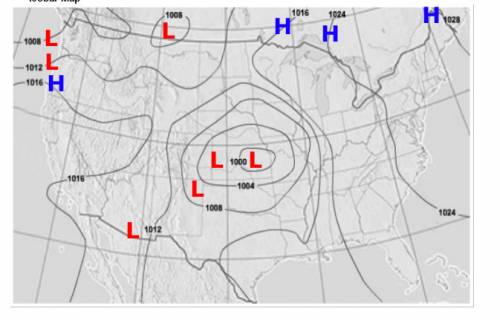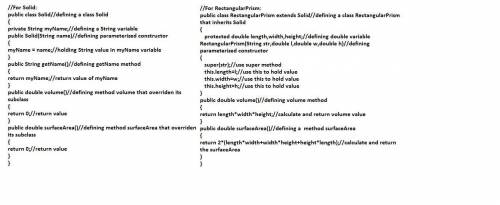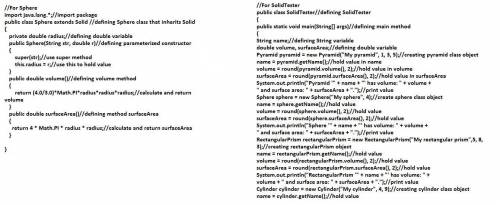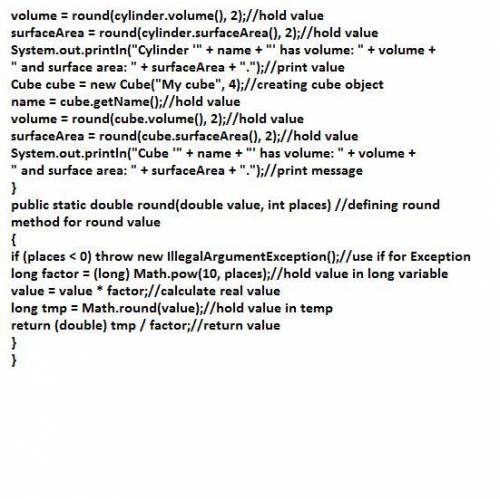-
CODE:
#include <iostream>
#include<cmath>
using namespace std;
float calcBaseArea(float a);
float calcSideArea(float s,float l);
void prntSprfArea(float base_area,float side_area);
int main()
{
float h;
float a;
float base_area
float side_area;
cout<<"Enter the side length of the base of the square pyramid in feet : ";
cin>>a;
cout<<"Enter the height of the square pyramid in feet : ";
cin>>h;
base_area=calcBaseArea(a);
side_area=calcSideArea(a,h);
cout<<"Base surface area of the square pyramid is "<<base_area<<" square feet. "<<endl;
cout<<"Side area of the square pyramid is "<<side_area<<" square feet."<<endl;
prntSprfArea(base_area,side_area);
return 0;
}
float calcBaseArea(float a)
{
return pow(a,2);
}
float calcSideArea(float s,float l)
{
float area=(s*l)/2;
return 4*area;
}
void prntSprfArea(float base_area,float side_area)
{
cout<<"Total surface area of the pyramid is "<<base_area+side_area<<" square feet.";
OUTPUT:

-
CODE:
#include <iostream>
#include<cmath>
using namespace std;
float calcBaseArea(float a);
float calcSideArea(float s,float l);
void prntSprfArea(float base_area,float side_area);
int main()
{
float h;
float a;
float base_area
float side_area;
cout<<"Enter the side length of the base of the square pyramid in feet : ";
cin>>a;
cout<<"Enter the height of the square pyramid in feet : ";
cin>>h;
base_area=calcBaseArea(a);
side_area=calcSideArea(a,h);
cout<<"Base surface area of the square pyramid is "<<base_area<<" square feet. "<<endl;
cout<<"Side area of the square pyramid is "<<side_area<<" square feet."<<endl;
prntSprfArea(base_area,side_area);
return 0;
}
float calcBaseArea(float a)
{
return pow(a,2);
}
float calcSideArea(float s,float l)
{
float area=(s*l)/2;
return 4*area;
}
void prntSprfArea(float base_area,float side_area)
{
cout<<"Total surface area of the pyramid is "<<base_area+side_area<<" square feet.";
OUTPUT:

need more info please and thank you
Explanation:
 108
108 Question 1 & 2. Image 1. All the high or low pressure areas are marked. Standard atmospheric pressure is 1,013.25 millibars. Everything above is high pressure and everything below is low pressure.
Question 3. Low pressure areas. These areas are basically storms. As hurricanes and blizzard are classified as storms, one expects snow or rain in areas with low atmospheric pressure.
Question 4. High pressure areas. These areas are associated with light winds and the phenomenon known as subscidence. Through adiabatic or compressional heating the air mass is ”dried out”. This is known as subscidence.
Question 5 & 6. Image 2. Northern Hemisphere: high pressure – clockwise direction, low pressure – counterclockwise
Question 7. As winds move in an anticlockwise manner around a low-pressure area, currently, the wind will blow from a southwestern to northeastern direction. However, as soon as the low-pressure area moves in, the wind will blow from a southeastern to a northwestern direction.
Question 8. As winds move in a clockwise manner around a low-pressure area, currently, the wind will blow from a southeastern to a northwestern direction. However, as soon as the high-pressure area moves in, the wind will blow from a southwestern to northeastern direction.
Question 9. Image 3. Strong winds are indicated by closely packed isobars as they indicate a steep horizontal pressure gradient.



 366
366 

need more info please and thank you
Explanation:
 108
108 Question 1 & 2. Image 1. All the high or low pressure areas are marked. Standard atmospheric pressure is 1,013.25 millibars. Everything above is high pressure and everything below is low pressure.
Question 3. Low pressure areas. These areas are basically storms. As hurricanes and blizzard are classified as storms, one expects snow or rain in areas with low atmospheric pressure.
Question 4. High pressure areas. These areas are associated with light winds and the phenomenon known as subscidence. Through adiabatic or compressional heating the air mass is ”dried out”. This is known as subscidence.
Question 5 & 6. Image 2. Northern Hemisphere: high pressure – clockwise direction, low pressure – counterclockwise
Question 7. As winds move in an anticlockwise manner around a low-pressure area, currently, the wind will blow from a southwestern to northeastern direction. However, as soon as the low-pressure area moves in, the wind will blow from a southeastern to a northwestern direction.
Question 8. As winds move in a clockwise manner around a low-pressure area, currently, the wind will blow from a southeastern to a northwestern direction. However, as soon as the high-pressure area moves in, the wind will blow from a southwestern to northeastern direction.
Question 9. Image 3. Strong winds are indicated by closely packed isobars as they indicate a steep horizontal pressure gradient.



 366
366  2
2 Following are the code to this question:
Explanation:
//For Solid:
public class Solid//defining a class Solid
{
private String myName;//defining a String variable
public Solid(String name)//defining parameterized constructor
{
myName = name;//holding String value in myName variable
}
public String getName()//defining getName method
{
return myName;//return value of myName
}
public double volume()//defining method volume that overriden its subclass
{
return 0;//return value
}
public double surfaceArea()//defining method surfaceArea that overriden its subclass
{
return 0;//return value
}
}
//For RectangularPrism:
public class RectangularPrism extends Solid//defining a class RectangularPrism that inherits Solid
{
protected double length,width,height;//defining double variable
RectangularPrism(String str,double l,double w,double h)//defining parameterized constructor
{
super(str);//use super method
this.length=l;//use this to hold value
this.width=w;//use this to hold value
this.height=h;//use this to hold value
}
public double volume()//defining volume method
{
return length*width*height;//calculate and return volume value
}
public double surfaceArea()//defining a method surfaceArea
{
return 2*(length*width+width*height+height*length);//calculate and return the surfaceArea
}
}
// For Cube:
public class Cube extends RectangularPrism//defining Cube class that inherits RectangularPrism
{
Cube(String name, double side) //defining parameterized constructor
{
super(name, side, side, side);//use super method
}
public double volume()//defining volume method
{
return length * length * length;//calculate and return volume
}
public double surfaceArea()//defining method surfaceArea
{
return 6 * length*length;//calculate and return surfaceArea
}
}
//for Cylinder:
import java.lang.*;//import lang package
public class Cylinder extends Solid//defining Cylinder class that inherits Solid
{
private double radius, height;//defining double variable
public Cylinder(String str, double r, double h)//defining parameterized constructor
{
super(str);//use super Method
this.radius = r;//use this keyword to hold value
this.height = h;//use this keyword to hold value
}
public double volume()//defining volume method
{
return Math.PI * radius * radius * height;//calculate and return volume
}
public double surfaceArea()//defining surfaceArea method
{
return 2 * Math.PI * radius * (height + radius);//calculate and return surfaceArea
}
}
//For Pyramid
import java.lang.*;//import package
public class Pyramid extends Solid//defining a Pyramid class that inherits Solid
{
private double length, width,height;//defining double variable
public Pyramid(String str, double l, double w, double h)//defining parameterized constructor
{
super(str);//use super method
this.length = l;//use this keyword to hold value
this.width = w;//use this keyword to hold value
this.height = h;//use this keyword to hold value
}
public double volume()//defining volume method
{
return (length*width*height)/3.0;//calculate and return volume
}
public double surfaceArea()//defining a method surfaceArea
{
return (length*width)+length*Math.sqrt((Math.pow((width/2),2)+(height*height)))+(width*Math.sqrt((Math.pow((length/2),2)+(height*height))));//calculate and return surfaceArea
}
}
//For Sphere
import java.lang.*;//import package
public class Sphere extends Solid //defining Sphere class that inherits Solid
{
private double radius;//defining double variable
public Sphere(String str, double r)//defining parameterized constructor
{
super(str);//use super method
this.radius = r;//use this to hold value
}
public double volume()//defining volume method
{
return (4.0/3.0)*Math.PI*radius*radius*radius;//calculate and return volume
}
public double surfaceArea()//defining method surfaceArea
{
return 4 * Math.PI * radius * radius;//calculate and return surfaceArea
}
}
please find attachment.





It will provide an instant answer!
